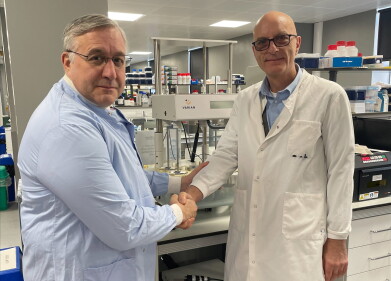News
Breakthrough brings high resolution to Brain imaging
Aug 23 2021
Scientists in Italy, the UK and Germany, have developed a technique that provides sharper and more richly detailed images of mouse brains, a breakthrough that could make developments in quantitative analysis of complex brain structures at the sub-cellular level possible.
Dr Ludovico Silvestri, first author of the study and researcher in Physics of Matter at University of Florence in Italy, said: “The lack of instruments capable of analysing large volumes at high resolution has limited our studies of brain-wide structure to a rough, low-resolution level.
“The currently employed method of light-sheet microscopy combined with chemical protocols capable of rendering biological tissues transparent, fails to maintain high resolution in samples larger than a few hundred microns.”
Dr Leonardo Sacconi, of the National Institute of Optics of the National Research Council (CNR-INO), a co-author of the paper, added: "Beyond these dimensions, the biological tissue begins to behave like a lens, disrupting the alignment of the microscope and consequently making the images blurry."
With their system, Rapid Autofocus via Pupil-split Image phase Detection (or RAPID), the researchers propose an auto-focusing technology that can correct misalignments and image degradation introduced by the sample itself in real time.
Compatible with light sheet microscopy, this new method was inspired by the optical autofocus systems found in reflex cameras, where prisms and lenses transforms the blur of an image into a lateral movement. This allows the alignment of the microscope to be stabilized in real time for improved imaging.
Dr Caroline Müllenbroich, a Marie SkÅ‚odowska Curie fellow and lecturer at the University of Glasgow’s School of Physics and Astronomy and also a co-author of the paper contributed to the design and implementation of the microscope and autofocusing system.
“While we originally invented RAPID for light-sheet microscopy, this autofocusing technology is actually suitable for all wide-field microscopy techniques. It is very versatile and sample agnostic with multiple applications beyond neuroscience,” Dr Müllenbroich said.
The high resolution enabled by RAPID - the subject of an international patent owned by Unifi, the European Laboratory of Nonlinear Spectroscopy (LENS) and CNR - has allowed researchers to study on a whole-brain scale problems previously analysed only in small, local areas.
For example, the spatial distribution of a particular type of neurons - which express somatostatin - has been investigated, showing how these cells tend to organise themselves in spatial clusters, which are suspected to make their inhibitory action more effective.
Another application concerns microglia, a set of cells with different functions (from the response to pathogens to the regulation of neuronal plasticity), whose shape changes according to the role they play. The analysis of microglia performed with RAPID revealed significant differences between various brain regions, paving the way for new studies on the role of this cell population.
The research was led by led by the University of Florence’s departments of Physics and Astronomy, Information Engineering and Biology, and CNR. RAPID was developed in LENS by researchers from the Biophotonics Area, headed by Francesco Pavone, Professor of Physics of Matter at the University of Florence.
In addition to the University of Glasgow, the Italian researchers also collaborated with scholars from the European Molecular Biology Laboratory in Heidelberg (Germany). The study was carried out within the European Flagship Human Brain Project, of which LENS and CNR are partners.
The team’s paper, titled ‘Universal autofocus for quantitative volumetric microscopy of whole mouse brains’, is published in Nature Methods.
More information online
Digital Edition
ILM 50.2 March 2025
March 2025
Chromatography Articles - Effects of small deviations in flow rate on GPC/SEC results Mass Spectrometry & Spectroscopy Articles - Waiting for the present to catch up to the future: A bette...
View all digital editions
Events
Mar 17 2025 Milan, Italy
Mar 18 2025 Beijing, China
Mar 20 2025 Brussels, Belgium
Mar 20 2025 Chandigarh, India
ACS National Meeting & Expo, Spring 2025
Mar 23 2025 San Diego, CA, USA



















